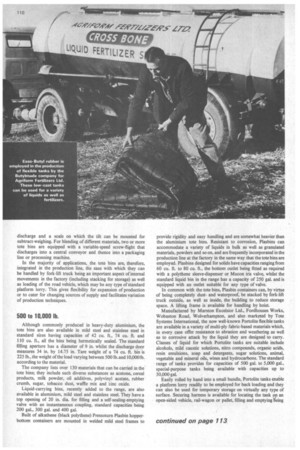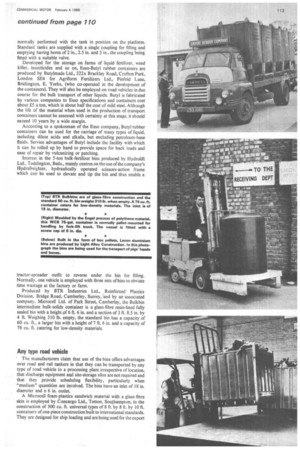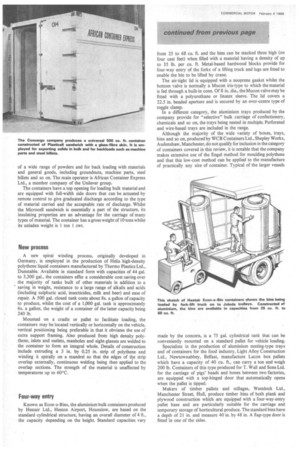Containers in the production line
Page 110

Page 111

Page 112

Page 115

Page 116

If you've noticed an error in this article please click here to report it so we can fix it.
BY P. A. C. BROCKINGTON, AM! Mech E
THE current role of the bulk-materials container that is transferred from road vehicle to depot or factory as a regular part of the traffic exercise is mainly related to a type of operation in which the container is at one stage integrated in the production line.
With the development of bulk-carrying vehicles having discharge systems that can unload the liquid, granulated material or powder into suitable storage vessels in a matter of minutes, the use of "on-off" containers for bulk transport of complete loads has not made the headway that was originally predicted, but there are indications that the smaller "universal" type of container built to international standards may find increasing favour for export traffic. In this case a container that can be employed for both bulk and cargo loads offers obvious advantages.
For export traffic, as well as operations in this country, the carriage of granulated or powdered solids in bulk containers predominates over the transport of bulk liquids, the conveyance of which is more normally performed in singleor multi-compartment tankers because of the large quantities involved. The roll-up type of flexible tank may well, however, foster the use of larger containers for the carriage of fluids, notably because it facilitates varied back-loading.
In a more general category, a number of manufacturers produce a range of smaller bulk containers that operators can employ selectively, if necessary, as a part of amixedload, without developing a relatively complex system to cater for their use. In the majority of cases such containers are pallet-loaded and the size of the container is determined by individual considerations. It is not uncommon for a vehicle operator to have containers built to his specification to suit a particular type of traffic.
. To assess the merits of the tote system marketed by Tote Systems International, the materials handling division of Pressoturn Ltd., Leamington Spa, Warwickshire, it is appropriate to examine the mechanical aids that can be used in the factory to feed the material to the production line. These include, for example, a tilt that can be elevated with a hoist or by pneumatic or hydraulic power, which provides for discharge by gravity or to a screwflight conveyor (including a variable-pitch type), a dischargeassisting vibrator, units providing automatic and remote control discharge and a scale on which the tilt can be mounted for subtract-weighing. For blending of different materials, two or more tote bins are equipped with a variable-speed screw-flight that discharges into a central conveyor and thence into a packaging line or processing machine.
In the majority of applications, the tote bins are, therefore, integrated in the production line, the ease with which they can be handled by fork-lift truck being an important aspect of internal movements in the factory (including stacking for storage) as well as loading of the road vehicle, which may be any type of standard platform lorry. This gives flexibility for expansion of production or to cater for changing sources of supply and facilitates variation of production techniques.
500 to 10,000 lb.
Although commonly produced in heavy-duty aluminium, the tote bins are also available in mild steel and stainless steel in standard sizes having capacities of 42 cu. ft., 74 Cu. ft. and 110 Cu. ft., all the bins being hermetically sealed. The standard filling aperture has a diameter of 9 in. whilst the discharge door measures 34 in. by 14.75 in. Tare weight of a 74 Cu. ft. bin is 225 lb., the weight of the load varying between 500 lb. and 10,0001b. according to the material.
The company lists over 130 materials that can be carried in the tote bins; they include such diverse substances as acetone, cereal products, milk powder, oil additives, polyvinyl acetate, rubber crumb, sugar, tobacco dust, waffle mix and zinc oxide.
Liquid-carrying bins, recently added to the range, are also available in aluminium, mild steel and stainless steel. They have a top opening of 20 in. dia. for filling and a self-sealing-emptying valve with an instantaneous coupling, standard capacities being 200 gal., 300 gal. and 400 gal.
Built of alkathene (black polythene) Pressoturn Plasbin hopperbottom containers are mounted in welded mild steel frames to
provide rigidity and easy handling and are somewhat heavier than the aluminium tote bins. Resistant to corrosion, Plasbins can accommodate a variety of liquids in bulk as well as granulated materials, powders and so on, and are frequently incorporated in the production line at the factory in the same way that the tote bins are employed. Plasbins designed for solids have capacities ranging from 60 Cu. ft. to 80 Cu. ft., the bottom outlet being fitted as required with a polythene sleeve-dispenser or Mucon iris valve, whilst the standard liquid bin in the range has a capacity of 250 gal. and is equipped with an outlet suitable for any type of valve.
In common with the tote bins, Plasbin containers can, by virtue of being completely dust and waterproof, be stacked by fork-lift truck outside, as well as inside, the building to reduce storage space. A lifting frame is available for handling by hoist Manufactured by Marston Excelsior Ltd., Fordhouses Works, Wobaston Road, Wolverhampton, and also marketed by Tote Systems International, the now well-known Portolite flexible tanks are available in a variety of multi-ply fabric-based materials which, in every case offer resistance to abrasion and weathering as well as to corrosive attack by the liquid they are designed to carry. Classes of liquid for which Portolite tanks are suitable include alcohols, mild caustic solutions, nitro compounds, organic acids, resin emulsions, soap and detergents, sugar solutions, animal, vegetable and mineral oils, wines and hydrocarbons. The standard range of tanks provides for capacities of 500 gal. to 5,000 gal., special-purpose tanks being available with capacities up to 30,000 gal.
Easily rolled by hand into a small bundle, Portolite tanks enable a platform lorry readily to be employed for back loading and they can also be used for temporary storage on virtually any type of surface. Securing harness is available for locating the tank on an open-sided vehicle, rail-wagon or pallet, filling and emptying geing normally performed with the tank in position on the platform. Standard tanks are supplied with a single coupling for filling and emptying having bores of 2 in., 2.5 in. and 3 in., the coupling being fitted with a suitable valve.
Developed for the storage on farms of liquid fertilizer, weed killer, insecticides and so on, Esso-Butyl rubber containers are produced by Butylmade Ltd., 322A Brackley Road, Crofton Park, London SE4 for Agriform Fertilizers Ltd., Pinfold Lane, Bridlington, E. Yorks, (who co-operated in the development of the containers). They will also be employed on road vehicles in due course for the bulk transport of other liquids. Butyl is fabricated by various companies to Esso specifications and containers cost about £5 a ton, which is about half the cost of mild steel. Although the life of the material when used in the production of transport containers cannot be assessed with certainty at this stage, it should exceed 10 years by a wide margin.
According to a spokesman of the Esso company, Butyl rubber containers can be used for the carriage of many types of liquid, including dilute acids and alkalis, but excluding petroleum-base fluids. Service advantages of Butyl include the facility with which it can be rolled up by hand to provide space for back loads and ease of repair by vulcanizing or patching.
Interest in the 5-ton bulk-fertilizer bins produced by Hydrolift Ltd., Toddington, Beds., mainly centres on the use of the company's Hydrafreighter, hydraulically operated scissors-action frame which can be used to elevate and tip the bin and thus enable a tractor-spreader outfit to reverse under the bin for filling. Normally, one vehicle is employed with three sets of bins to obviate time wastage at the factory or farm.
Produced by BTR Industries Ltd.,Reinforced Plastics Division. Bridge Road, Camberley, Surrey:and by an associated company. Microcell Ltd. of Park Street, Camberley, the Bulkbin intermediate bulk-solids container is a glass-fibre resin-lined fully sealed bin with a height of 6 ft. 6 in. and a section of 3 ft. 8.5 in. by 4 ft. Weighing 310 lb. empty, the standard bin has a capacity of 60 Cu. ft., a larger bin with a height of 7 ft. 6 in. and a capacity of 76 cu. ft. catering for low-density materials.
Any type road vehicle The manufacturers claim that use of the bins offers advantages over road and rail tankers in that they can be transported by any type of road vehicle to a processing plant irrespective of location, that discharge equipment and site-storage silos are not required and that they provide scheduling flexibility, particularly when "medium" quantities are involved. The bins have an inlet of 18 in. diameter and a 6 in. outlet.
A Microcell foam-plastics sandwich material with a glass-fibre skin is employed by Concargo Ltd., Totton, Southampton, in the construction of 500 cu. ft. universal types of 8 ft. by 8 ft. by 10 ft. containers of one-piece construction built to international standards. They are designed for ship loading and are being used for the export
of a wide range of powders and for back loading with materials and general goods, including groundnuts, machine parts, steel billets and so on. The main operator is African Container Express Ltd., a member company of the Unilever group.
The containers have a top opening for loading bulk material and are equipped with full-width side doors that can be actuated by remote control to give graduated discharge according to the type of material carried and the acceptable rate of discharge. Whilst the Microcell sandwich is essentially a part of the structure, its insulating properties are an advantage for the carriage of many types ,of material. The container has a gross weight of 10 tons whilst its unladen weight is 1 ton 1 cwt.
New process
A new spiral winding process, originally developed in Germany, is employed in the production of Helix high-density polythene liquid containers manufactured by Thermo Plastics Ltd., Dunstable. Available in standard form with capacities of 44 gal. to 3,300 gal., the containers offer a considerable cost saving over the majority of tanks built of other materials in addition to a saving in weight, resistance to a large range of alkalis and acids (including sulphuric acid, insecticides, milk and beer) and ease of repair. A 500 gal. closed tank costs about 8s. a gallon of capacity to produce, whilst the cost of a 1,000 gal. tank is approximately 6s. a gallon, the weight of a container of the latter capacity being 240 lb.
Mounted on a cradle or pallet to facilitate loading, the containers may be located vertically or horizontally on the vehicle, vertical positioning being preferable in that it obviates the use of extra support framing. Also produced from high density polythene, inlets and outlets, manholes and sight-glasses are welded to the container to form an integral whole. Details of construction include extruding a 3 in. by 0.25 in. strip of polythene and winding it spirally on a mandrel so that the edges of the strip overlap externally, continuous welding being then applied to the overlap sections. The strength of the material is unaffected by temperatures up to 60°C.
Four-way entry
Known as Econ-o-Bins, the aluminium bulk containers produced by Hestair Ltd., Heston Airport, Hounslow, are based on the standard cylindrical structure, having an overall diameter of 4 ft., the capacity depending on the height. Standard capacities vary from 25 to 68 Cu. ft. and the bins can be stacked three high (on four cast feet) when filled with a material having a density of up to 35 lb. per cu. ft. Metal-based hardwood blocks provide for four-way entry of the forks of a lifting truck and lugs are fitted to enable the bin to be lifted by crane.
The air-tight lid is equipped with a neoprene gasket whilst the bottom valve is normally a Mucon iris-type to which the material is fed through a built-in cone. Of 8 in. dia., the Mucon valvemay be fitted with a polyurethane or linatex sleeve. The lid covers a 22.5 in. beaded aperture and is secured by an over-centre type of toggle clamp. In a different category, the aluminium trays produced by the company provide for "selective" bulk carriage of confectionery, chemicals and so on, the trays being nested in multiple. Perforated and wire-based trays are included in the range.
Although the majority of the wide variety of boxes, trays, bins and so on, produced by WC B Containers Ltd., Shepley Works, Audenshaw, Manchester, do not qualify for inclusion in the category of containers covered in this review, it is notable that the company makes extensive use of the Engel method for moulding polythene and that this low-cost method can be applied to the manufacture of practically any size of container. Typical of the larger vessels made by the concern, is a 75 gal, cylindrical tank that can be conveniently mounted on a standard pallet for vehicle loading.
Specialists in the production of aluminium nesting-type trays and of containers for the food industry, Light Alloy Construction Ltd., Newtownabbey, Belfast, manufacture Lacon box pallets which have a capacity of 40 cu. ft., can carry a ton and weigh 200 lb. Containers of this type produced for T. Wall and Sons Ltd. for the carriage of pigs' heads and bones between two factories, are equipped with a top-hinged door that automatically opens when the pallet is tipped.
Makers of timber pallets and stillages, Westdock Ltd., Manchester Street, Hull, produce timber bins of both plank and plywood construction which are equipped with a four-way-entry pallet base and are particularly suitable for the carriage and temporary storage of horticultural. produce. The standard bins have a depth of 21 in. and measure 40 in. by 48 in. A flap-type door is fitted in one of the sides.




































































































































































































